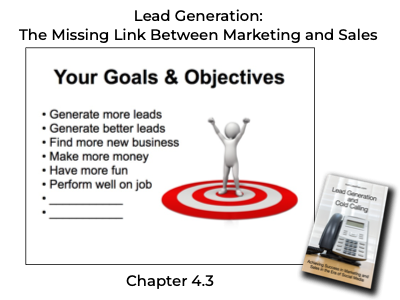Category: Cold_Calling

I got into a bit of a debate today with a Marketing expert on the importance of identifying your Ideal Customer Profile, or ICP.
They claim that it's something you have to do. I claim it's wrong, and that it leads to waste and an enormous number of failures, when it comes to marketing and sales.
In short, according to them, the Ideal Customer Profile provides a detailed description - using attributes such as demographics, firmographics, psychographics and behavioral data to characterize prospects who are most likely to buy your product or service.
Your job then becomes to focus your marketing and sales efforts on those archetypes because, supposedly, that's where you'll get the biggest bang for your buck.
The problem is that, as a strategy, it's almost entirely wrong. And the reason is simple.
In short, the ICP concept conflates Target Marketing and Market Segmentation, and ends up sub-optimizing both.
Here's what you need to know:
Target Markets are groups of prospects (or customers) who have common demographics, firmographics, psychographics, that can be effectively targeted in the media or with sales development efforts.
Market Segments are groups of prospects (or customers) who have common "needs, pains, problems and unmet goals" that you can address.
And rarely do those groups overlap.
Basically, your goal should be to find and reach your market segments. You may only be able to do that via targeting accessible attributes, but if you start by targeting an ICP you will generally miss your market - even if you iterate.
Sorry, but this is just a huge fallacy in the industry. And it leads to a huge number of marketing failures.
[more]

The classic model that we use for this process, which actually dates back to the 1930’s, is called “AIDA.”
AIDA stands for getting the prospect’s Attention, stimulating their Interest, getting them to Desire or want to do something about it, and then getting them to actually Act on that desire. Although it originally applied to consumer sales, we’ve found that these four steps are equally effective in B2B cold calling. And they provide an excellent model for designing both a cold call and a cold calling program.
Consequently, that’s what we’re going to do today, design a cold calling program, and your cold call, around this AIDA model so you can make more money, have more fun, and achieve the success you want to achieve.
[more]

Cold Calling 101: 4.13 Creating Demand
In our experience, the process of creating demand starts with finding a suspect, someone who could potentially buy your product or service.
It then means getting their attention and engaging them in a conversation where you uncover their needs, pains and problems, as well as their unrealized hopes, dreams and goals, with which you can help. It then means getting them to want to solve those problems and achieve those goals, ideally sooner rather than later.
It also means positioning your product or service as a solution, as a means to those ends, and then getting the prospect to commit to a meeting with you or your rep to talk about it as the next step in the process of getting there.
But creating demand, and successful cold calling in particular, is the quintessential case of making something out of nothing, or at least out of nothing more than a phone call.
[more]

Cold Calling 101: 4.12 Cold Calling Scenarios
The skills that you’re going to learn in this course are vital though, and they work, regardless of whether you’re just trolling for needs, or you have to actually educate the prospect in order to get in the door, or any situation in between. This is because even if you’re just trolling for needs, you probably still have to unhook a competitor, which takes skill. And the fact of the matter is that if your only advantage is price, you’re only hurting yourself if all you do is offer a discount in order to win the business.
But the main reason that you need to understand the full technique is that, regardless of how you go to market, account control, the foundation for which is built during the cold call, is critical to your long-term success. So learning these techniques will not only help you find more business, it will help you close it, and keep it too, no matter what kind of market you’re competing in.
[more]

Cold Calling 101: 4.11 The Purpose of Cold Calling
Before we get too far into the methodology – and understand that we have a long way to go – we need to talk about what cold calling means to you and for your company. This is because, for some companies, demand is just out there and all you have to do is look for it, while other companies have to actually create demand for their products or services.
For example, if you’re selling a commodity that everyone needs, then getting a shot at the business is often just a matter of calling a Purchasing Manager and offering a lower price. On the other hand, if you have to educate your prospects about your application or persuade them of your value, or get them to see the need before they can be interested (or if you want to raise your prices in a commoditized market) that’s a different and much tougher problem.
[more]

Cold Calling 101: 4.10 Objectives of the Course
One problem, as we said, is that most companies, and most sales and marketing managers, simply don’t know what works when it comes to cold calling. Most resort to the old adage of “smile and dial.” Or they tell you it’s a numbers game, and that the more calls you make, the more leads you’ll get. But if you don’t know what you’re doing, and you don’t have a process that actually works, doing the same thing over and over again, and expecting a different result is, as they say, the very definition of insanity.
In this course, however, you’re going to learn exactly what works, and how to make it work for you. How to get past gatekeepers and voice mail, how to reach decision makers, how to stimulate interest and uncover needs for your products or services, how to create urgency and stop the endless postponements, and how to persuade your prospect to want to meet, and eventually to buy. In short, how to generate high quality leads that result in more sales, at a lower cost, with less time and effort, while having more fun, and all the rewards that come with success.
[more]

So that’s why we’re here, and this is where we want to go, to enable you to generate high quality appointments that lead to more sales, more income and more fun, while expending less time, effort, money and frustration.
So with that as our goal, let’s drive it down a level, starting with how do we get there.
[more]

Cold Calling 101: 4.8 Benefits of Success
On the other hand, success can have its benefits. Being able to generate a steady stream of high-quality appointments (ones that convert into sales) is the lynchpin for growth at many companies. It means revenue success, opportunity, and growth, not just for you, but for your entire company. Success is certainly more fun than failure, and it can feed on itself, leading to higher pay, promotion, and even faster growth rates, as success, as they say, breeds success.
[more]

Cold Calling 101: 4.7 Consequences of Failure
For many sales and marketing professionals, not being able to generate new business can quickly lead to missed expectations, revenue shortfalls, frustration, and job loss, particularly when other marketing activities aren’t available to pick up the slack. And it’s often not just you who suffers. If you’re supposed to be making appointments for an outside salesperson, it means they may miss their numbers, the production department may have to cut back, and, of course, your own family may pay a price for your poor performance.
So while success can have benefits, failure on the phones can pull the rug out from under you, your job, your co-workers and your company.
[more]

Cold Calling 101: 4.6 Ineffective Techniques
But other approaches to lead generation work even less well, and often cost much more.
For example, while John Wanamaker said a hundred years ago, “Half my advertising budget is wasted, I just don’t know which half,” today it’s perfectly easy to waste your entire advertising budget. Networking is fine if you like trying to sell to people who can’t buy. Email gets your Web site blacklisted. SEO is an arms race where the only winners are the search providers. Using social media for B2B is like trying to get nominated for Best Supporting Actor. Most PR is nothing but a bit bucket. And Decision Makers don’t go to trade shows.
So the pressure to perform falls right back on the individual telemarketer, salesperson or business development specialist, pressure that usually just mounts until something, or someone, breaks.
[more]

Cold Calling 101: 4.5 What Have You Tried?
These problems are exacerbated by the fact that most sales directors, call center managers, marketing professionals and business owners simply don’t know what works to generate a good lead on the phone. So they fall back on the numbers game, a classic case of doing the same thing over and over again, and hoping for a different result.
Or they use the threat of firing to motivate high performance, a truly Darwinian solution for those who believe that creative destruction is capitalism’s greatest virtue, when the real problem is that they basically don’t know what they’re doing.
[more]

Cold Calling 101: Your Challenges
The problem is, though, that it isn’t easy to do, particularly with some products, and in some markets.
You may be challenged by bad lists, getting past gatekeepers, rejection or inaccurate information on who the decision makers are. You may have trouble stimulating interest because people don’t seem to respond to your message. You may be getting dumped into voice mail. Or you may just be getting blocked by objections like no need, no interest, the presence of an incumbent vendor, or everyone’s favorite objection: not now.
[more]

Cold Calling 101: Your Goals and Objectives
If you’re like most people who are responsible for finding new business or making appointments, you know that cold calling can be one of the most powerful weapons in your marketing arsenal, provided that you can do it well.
Having a painless and effective approach for cold calling means that you can generate more and better qualified sales leads, and find more new business for your company, faster, more consistently and for a far lower cost and risk compared to advertising, direct mail, SEO, networking, trade shows, social media marketing, PR or any of the hundreds of other marketing solutions.
[more]

In this series we’re going to show you how to generate Qualified Sales Leads using the example of developing and implementing a cold calling program in order to sell a Cold Calling service. As you can surmise, we use cold calling as the example go-to-market tactic because it’s one of the most challenging to execute effectively.
For example, it requires you to understand your prospects’ needs, and know how to get their attention. It requires you to stimulate their interest. It requires you to get them to want to talk with you, meet with you, and potentially buy from you. It requires you to get them to take some action, like provide information or get another decision maker involved, in order to move the Sell Cycle forward. And it requires you to do all this in barely a few seconds, where they can easily hang up on you if you’re not really, really good.
So let’s mount up.
[more]

Another brain teaser from the puzzle lab at LeadGen.com.
A little easier then the first one, and one less error.
The real question is: Isn't Marketing just another puzzle?
While you're contemplating the meaning of life, the universe, and everything, if you need help with any aspect of your Sales or Marketing program, call us!
[more]

Stupid Marketing Tricks: Email Edition
Back in the day, salespeople who were afraid to make cold calls, or who didn't know how to open one, would employ an excuse on their calls such as "I'm calling to follow up a letter I sent you..." - never actually having sent a letter. They did this as a way to make the call seem less cold.
And prospects were often dumb enough to fall for it, or too polite to challenge it. And so the prospect would apologize, and tell the salesperson that they didn't get the letter.
"Oh, sorry," the salesperson would say, "I guess it hasn't arrived yet," knowing full well that no letter was ever sent. "But as long as I have you on the phone, do you have a minute?"
And off they'd go...
Fast forward, and today lazy marketers don't even bother making the phone call. Instead, they send misleading emails, and hope someone is stupid enough to respond.
How many emails like these have you received:
• "I tried reaching you by phone, but apparently you were out."
• "I don't know if you got my voice mail, but I was hoping to catch you at your desk."
• "I'm following up my previous emails to see if you're still interested."
Setting aside that these things clog up your inbox, the real tragedy is that is that someone is actually paying for this.
Some poor business owner has bought into the drip email process, probably because he or she can't find salespeople who actually know how to sell. And, of course, email is cheap.
The problem is that, by the time this business owner finds out that it didn't work, they've blown half their year.
And their salespeople are on to their next jobs.
[more]

Have you even gotten one of those pitches from a call center where they brag about the high number of dials they can make each day, and it sounds high but reasonable?
And then as icing on the cake they tell you that they can generate lots of great leads too, and it sounds even better?
Run the math, though, and you may find out you're about to get snockered.
Let's assume that it takes three minutes to dial someone - because you have to familiarize yourself with who they are and what they do. Otherwise, of course, it will sound like you're reading from a script, and they'll just hang up on you.
So that 100 dials/day will take about 300 minutes, or 5 hours - assuming no bathroom breaks.
Then ask yourself: If the caller actually gets someone on the line, how long do you think it will take for them to persuade a prospect to agree to a meeting? Ten minutes? (Ten if you're lucky, but probaby more like twenty. But let's run with ten.)
And how many of these ten minute conversations would the caller have to have to get one person to say yes? Five? (Again, five if you're lucky, but probably more like ten.)
So here's the math: Five appointments required 25 conversations, each of which took ten minutes (not counting the time it takes to write notes), for a total of 250 minutes. Add that to the five hours from before, and you have a 9 hour day.
Do you know what a "blivit" is?
[more]